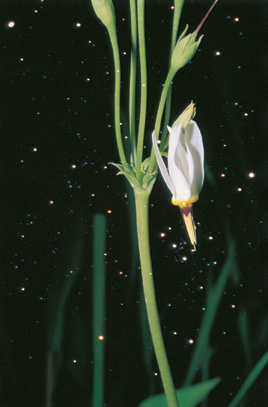

Shooting star lily
Photo by David Krohne
Magazine
Winter/Spring 2002
A
crossing
by Pattiann Rogers
Even as I set the alarm for 2:30 a.m. I was thinking, I don’t really
want to do this. I’ll have to get out of bed in the middle of the
night. It will be really cold and eerie. Nobody else will be out, maybe
a few truckers on the road, a police cruiser. I can always watch it on
television tomorrow.
But something inside kept insisting, “You should see this for yourself.”
So at 2:30 a.m. I woke and roused my husband, who was less reluctant
than I. We headed toward Daniels Park located above an immense valley
beyond which stretches the Front Range of the Rockies. Here we would have
a clear, open view of the moonless night sky.
When we reached the park, I was stunned at the number of people gathered.
We were in a crowd. The parking lot was filled. Cars and pickup trucks
lined both sides of the road. People were out of their vehicles, women
with coats thrown on over their nightclothes, men in jackets and sweat
pants, children in pajamas. Everyone was looking up, pointing, gasping,
occasionally shouting. And when I looked, I too saw them—the fiery
streaks of the Leonid meteors, in the west, in the east, directly overhead.
It was a magnificent sight, these whizzing streaks of light in the night
sky. I was tremendously moved. But why? I’d seen fireworks displays
that were brighter, more colorful and elaborate than these silent meteors
coming singly, in two’s and three’s, spaced erratically. What
had compelled all of us to come out in the middle of the night and to
stay, watching the skies? Not one of us was afraid of these “falling
stars.”
It was a glorious, almost hallowed, event. And one reason it was inspiring
is that its occurrence had been predicted and its cause explained by astronomers.
I knew the earth was moving through the remains left from the passage
of the comet Tempel-Tuttle. I was moving with the earth through the dust
and gravel particles left behind by this comet as it traveled through
our solar system. The fiery streaks I saw in the sky were those particles
burning as they entered the earth’s atmosphere. By understanding
this, I could envision my place in a system of moving cosmic bodies. I
was standing in the midst of dark space, traveling at this moment on my
earth crossing the path of a comet. I was witnessing this crossing.
In the early morning hours of November 18, 2001, I and many others were
privileged to watch a celestial display of great and powerful beauty without
fear, without panic, without conjecturing that the end of the world or
the wrath of God was upon us, as peoples of the past had conjectured during
similar displays. I was free to delight in one aspect of the intricate
workings of the universe, to be filled again with reverence for the size
and complexity of this physical world of which we are a part. I was able
to see and define myself anew within a vast history of cosmic events.
This was an inestimable gift to me, and I am grateful.
Pattiann Rogers has published numerous books of poetry, including Song
of theWorld Becoming: New and Collected Poems 1981-2001 and
Firekeeper, a finalist for the Lenore Marshall Poetry Prize. She
lives with her husband, John, a retired geophysicist, in Colorado.
Return to INCENSE
Return to the table of contents
